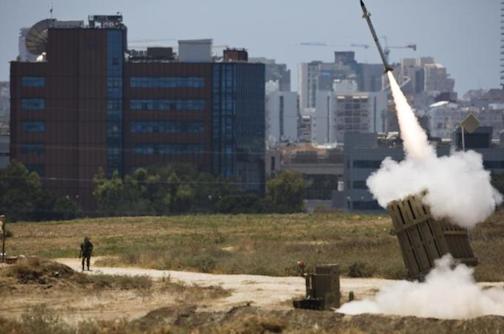| Editor's Commentary: We previously ran an article that noted Israel appears to be using banned weapons against Palestinians, experimenting on them as it were, to get a good look at the damage these weapons could do. As noted, Israel - of all peoples - should be keenly aware of the atrocity of experimenting on other human beings. As the following article suggests, there might actually be more of a commercial motive to the current assault against Gaza. Gotta love the entrepreneurial spirit. - prh, Editor Axis of Logic
Operation Protective Edge, Israel's name for its latest war on the Gaza Strip, shares many characteristics with its predecessors of 2008 and 2012. Once again, there is a high casualty rate among Palestinian civilians, especially women and children. Israeli forces are again targeting the family homes of suspected members of armed Palestinian groups as part of the policy of collective punishment used to deter Palestinian resistance. But this time around, there is something new - the ability of armed Palestinian groups in Gaza to reach towns and cities deep inside Israel with their crude missiles. It is the first time they have reached as far as Haifa and Ben Gurion airport. Israel's Iron Dome defence system is designed to act as a shield against missiles and artillery shells fired from Gaza - and it has attracted great attention from international media. Major news outlets such as CNN, the BBC, Sky News, The New York Times and The Telegraph, have carried daily news and operational information of the Iron Dome's successes. The Dome's fame has even reached prominent business outlets such as Bloomberg and The Wall Street Journal. Reporting on the Dome has provided near-real time televised war coverage. The media has repeated statistics demonstrating its success rates - although there appears to have been a reluctance to scrutinise official Israeli figures and an absence of voices from those who might question its effectiveness. It is understandable that Israeli officials would want to promote the idea of the Dome's success. It gives the Israeli public a sense of safety and security. It demonstrates that the state is fulfilling one of its commitments to its citizens - the duty to protect. But it is undeniable that this unquestioning tone helps provide a certain marketing message. The mainstream media narrative is framed to show the conflict as one between the democratic state of Israel and Islamic "terrorist" groups - especially Hamas - with little or no mention of Israel's occupation, or the eight-year siege of the Gaza Strip. So the message is clear - the Dome is an effective and highly desirable product, made in Israel and employed on the front line against Islamic terror, able to be customised to meet the needs of potential buyers. The marketing message is designed to link Palestinian groups which resist Israel's siege and occupation with armed groups around the world, subliminally suggesting that Israel is fighting the same threats - unexpected attacks designed to create fear in the public - as many other "civilised" countries. The Dome is, according to Israel's security industrial complex, an effective and successful high-performance instrument in the fight against both local and international terrorism. It protects not only the general public in their homes but also important soft targets with limited defence systems - civilian airports, government buildings, public spaces, and so on - making missile attacks ineffective. Israel is also eager to show the Dome as an ongoing development. Shortly after the launch of operation Protective Edge, the Israel Army deployed new Dome units described as advanced and able to meet the diversity of missiles launched from Gaza. The tacit message is that the war on Gaza is an experiment in real life - where people are the mice of this war laboratory, and the results are televised for the world. Of course, the Israel security establishment censors, as a war measure, what information is made available for public consumption. But it does keep feeding news outlets with new information about the Dome's achievements. At the same time, opinions that question its effectiveness, such as an analysis that recently appeared in the MIT Technology Review, is given little international attention. The latest round of war on Gaza Strip has neither promoted Israeli objectives nor met the Israeli criteria of war. It is a military operation that was widened as a result of a dispute between Israeli Prime Minister Benjamin Netanyahu and Foreign Minister Avigdor Lieberman. The war on Gaza might have been launched as a warning to armed Palestinian groups, but Israel's security institutions and associated corporate interests have exploited the situation, constructing an advertisement event for the Iron Dome system from the ravages of war. Israel, as a colonial state, is run by the security apparatus headed by the army, and private security companies such as RAFAEL. Following Operation Pillar of Defense, launched against Gaza in November 2012, seven nations, including the United States and South Korea, expressed interest in buying some variant of the Iron Dome system. As the Israeli economy depends on the sale of weapons and other military equipment, this latest round of war on Gaza is another opportunity for Israel's weapon consortium to boost its business around the world. Israel has already succeeded in securing additional funding from Washington to develop the Dome even further. Israel's intransigent approach to the political issue of the colonisation of Palestine - whereby it employs security solutions rather than working towards a political settlement - may in some part be explained by the Iron Dome's profitability. Samer Jaber is a political activist and researcher. He holds a master's degree in Sustainable International Development from Brandeis University, and studied at the Kennedy School at Harvard University and MIT. He served six years' political internment in Israeli jails during the first Palestinian intifada. Source URL |
